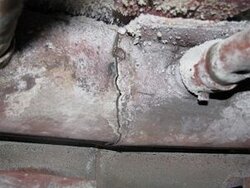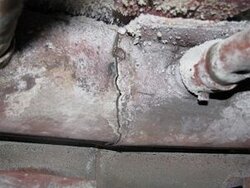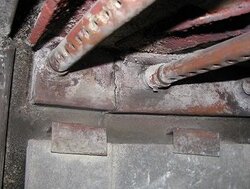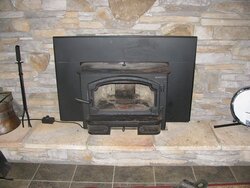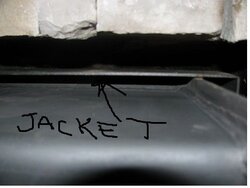Hello All! I am looking for some solid advice on a problem I just realizedI have with my LOPI Freedom Insert. It seems that I have developed a few cracks along the top air flow box where the baffles tie into. It's cracked in 4 area's and I "hopefully" attached pics correctly to this post. Onr chimney guy told me not to burn while another said it probably wasn't cracked through the box and to get it welded and I should be ok. Anyone ever have this happen? or get a stove welded? I'm not sure what to do! thanks fgor any help.
Cracks in LOPI Freedom
- Thread starter rakuz66
- Start date
-
Active since 1995, Hearth.com is THE place on the internet for free information and advice about wood stoves, pellet stoves and other energy saving equipment.
We strive to provide opinions, articles, discussions and history related to Hearth Products and in a more general sense, energy issues.
We promote the EFFICIENT, RESPONSIBLE, CLEAN and SAFE use of all fuels, whether renewable or fossil.
You are using an out of date browser. It may not display this or other websites correctly.
You should upgrade or use an alternative browser.
You should upgrade or use an alternative browser.
- Status
- Not open for further replies.
weezer4117
Feeling the Heat
The steel can be welded, my concern is how it cracked? The crack in the pictures is on your secondary air inlet wich feeds the 3-4 air tubes under the baffle, I wouldnt use the stove in this condition. How old is it? Have you ever got it abnormally hot?
Thanks for your resonse. The stove is about 7 yeras old and yes I have gotten it abnormally hot in the past. I wasn't as educated on it as I am now. Live and learn I guess. I was also told that welds typically hold for about 2-3 years and then crack again. I am leaning towards getting a new insert, any thoughts?? By the way, looking into a Regency insert, does anyone have any opinions on Regency? Also , I was told to keep any new insert around 500 degrees max. I never used a thermostat before, so do they sit on top of the stove? I want to make sure that this doesn't happen again.
kingquad
Minister of Fire
Regency makes a very good product. It was high on my list till I found out that it wouldn't fit in my fireplace. I think Regency is offering a free blower offer with their inserts right now too. They usually charge extra. I have an Enviro and constantly run it much higher than 500. I see about 700 pretty consistently early in the burn cycle on a full load. After about an hour or two, it will level out to about 500-550 where it will stay for a few hours and then begin to cool slowly over the next few hours. The problem is finding a good spot to measure the temp on an insert. Get a cheap IR laser thermometer at Harbor Freight or Amazon.rakuz66 said:Thanks for your resonse. The stove is about 7 yeras old and yes I have gotten it abnormally hot in the past. I wasn't as educated on it as I am now. Live and learn I guess. I was also told that welds typically hold for about 2-3 years and then crack again. I am leaning towards getting a new insert, any thoughts?? By the way, looking into a Regency insert, does anyone have any opinions on Regency? Also , I was told to keep any new insert around 500 degrees max. I never used a thermostat before, so do they sit on top of the stove? I want to make sure that this doesn't happen again.
weezer4117
Feeling the Heat
rakuz66 said:Thanks for your resonse. The stove is about 7 yeras old and yes I have gotten it abnormally hot in the past. I wasn't as educated on it as I am now. Live and learn I guess. I was also told that welds typically hold for about 2-3 years and then crack again. I am leaning towards getting a new insert, any thoughts?? By the way, looking into a Regency insert, does anyone have any opinions on Regency? Also , I was told to keep any new insert around 500 degrees max. I never used a thermostat before, so do they sit on top of the stove? I want to make sure that this doesn't happen again.
It is common for welds to get weak with the constant temparature changes but the crack on your stove isnt on a weld
 On my Buck 74 I put the thermometer on the top, right corner of the door(you can see it in my avatar). They are a must IMO, it allows you to control your stove much better and realize any abnormal temp changes. It also allows you to properly close down your primary air and kick in you secondaries.....
On my Buck 74 I put the thermometer on the top, right corner of the door(you can see it in my avatar). They are a must IMO, it allows you to control your stove much better and realize any abnormal temp changes. It also allows you to properly close down your primary air and kick in you secondaries.....Yep, that is a healthy crack on the secondary manifold. It looks like it happened right where the manifold changes its angle. Is the other side ok? I only see one long crack here. Where are the other 3 cracks?
I'm wondering why the stove got too hot. Was the bypass left open or were the baffle bricks not correctly in place?
I'm wondering why the stove got too hot. Was the bypass left open or were the baffle bricks not correctly in place?
BeGreen, No the other side is exactly the same. You are correct , it cracked in 4 places, where the manifold changes angles. I'm wondering why the stove got too hot myself? I never had a thermometer on the stove, and I did burn it "Hot", but that was the exception, not the norm. Like I said, live and learn. Do you think it is repairable? or should I have peace of mind, and just get a new one, along with a thermometer? Mind you, I don't have the $$, but I have lots of firewood, a log splitter, chain saw, etc. I'm geared up for a wood stove. I'm considering all options, thanks in advance.
Highbeam
Minister of Fire
So three photos of the same crack. I get that the opposite side is the same so that's two cracks. Where are the other 2?
I owned a Lopi freedom bay insert. They are the type of stove that Lopi says that overfire is when something glows red or 800 and above sustained. Sis you make it glow?
Your air tube is also in the wrong orientation. The right one in the photo, it should face somewhat forward like the left one is doing and the pins are supposed to hold the angle.
Why not weld it. Some guy can shove a cheezy little wirefeed welder in there and zip them closed in no time flat. You've got nothing to lose, so what if it cracks again in a few years.
If you just want a new stove then get it, but those cracks are not in a critical place. Figure that if they cause a leak it will be just like the tubes an inch away with all the holes. I might even just schmear furnace cement over it to see what happens.
I owned a Lopi freedom bay insert. They are the type of stove that Lopi says that overfire is when something glows red or 800 and above sustained. Sis you make it glow?
Your air tube is also in the wrong orientation. The right one in the photo, it should face somewhat forward like the left one is doing and the pins are supposed to hold the angle.
Why not weld it. Some guy can shove a cheezy little wirefeed welder in there and zip them closed in no time flat. You've got nothing to lose, so what if it cracks again in a few years.
If you just want a new stove then get it, but those cracks are not in a critical place. Figure that if they cause a leak it will be just like the tubes an inch away with all the holes. I might even just schmear furnace cement over it to see what happens.
Highbeam, the pics are of the left side. There are 2 cracks on each side, the one you see and one in the back corner where it makes a 90 degree turn, same on the right side as well. I guess my concern is this : what if the crack is in the actual box itself? How can I check to see if the outside box is ok? By the way, I don't ever remember it glowing red, but I do remember hearing some loud bangs last year, I bet that's when they cracked. Is there any other reason it would crack besides burning too hot?
Hard to say why they cracked or why the stove was running hot. It could have happened if the baffles were not seated correctly. Or it could have been the wood if a lot of carpentry scraps or palettes were being burned. Or it could have been operator error, by putting a reload on too hot a coal bed or leaving the air open too much for too long?
Have you contacted a local Lopi dealer about the issue? I am wondering if the manifold is replaceable or not. If it isn't, I'm with Highbeam. Fix the cracks by welding or smearing furnace cement in them?
Have you contacted a local Lopi dealer about the issue? I am wondering if the manifold is replaceable or not. If it isn't, I'm with Highbeam. Fix the cracks by welding or smearing furnace cement in them?
BeGreen said:Fix the cracks by welding or smearing furnace cement in them?
You got it. That is cooler air coming in through the manifold. With the Freedom insert you should be able to see it it cracked through the firebox wall with a flashlight on the outside of the firebox.
budman
Minister of Fire
BeGreen, Just burning good seasoned wood is all. I'll admit that I burned it "hot" once in a while, but not consistently. I can't contact LOPI myself, but the dealer contacted them and the manifold is "Not Replaceable." If anyone knows the contact numbers for LOPI, I would appreciate it!
BBart, I did check the firebox, but it seems that there is a thin plate that runs around the outside of the firebox. It's about 1/16 of an inch or so outside of the firebox creating a slight gap. So it looks fine, but I'm only actually looking at that thin plate, not the actual firebox.
Budman, my door gasket was giving me problems last year and I replaced it this year. Prior to finding out about the cracks.
If I get a welder to come out, will they be able to pull the stove and check it all out 100%? Can I pull the stove out myself and check it out? I don't want to try and tackle something I can't handle, but I'm pretty handy. How is the stainless steel liner connected?
Overall, if there are no further cracks in the stove and I get these welded, should I be "safe" and " ready to burn again" ? Issue is my wife and I are worried about this and want to be sure we are safe.
BBart, I did check the firebox, but it seems that there is a thin plate that runs around the outside of the firebox. It's about 1/16 of an inch or so outside of the firebox creating a slight gap. So it looks fine, but I'm only actually looking at that thin plate, not the actual firebox.
Budman, my door gasket was giving me problems last year and I replaced it this year. Prior to finding out about the cracks.
If I get a welder to come out, will they be able to pull the stove and check it all out 100%? Can I pull the stove out myself and check it out? I don't want to try and tackle something I can't handle, but I'm pretty handy. How is the stainless steel liner connected?
Overall, if there are no further cracks in the stove and I get these welded, should I be "safe" and " ready to burn again" ? Issue is my wife and I are worried about this and want to be sure we are safe.
Gomez
Member
I have the same stove with cracks at the bend towards the back of the manifold. What kind of furnace cement is best for this application?
Highbeam
Minister of Fire
I have used rutland black to seal cracks on the cermamic baffle with excellent results.
What are you worried about? Even if there was a big crack on the outside it would suck air into the stove. Fireboxes are in a vacuum.
How do you know you ever got it too hot? You have no meter and you never saw it glow anywhere. The freedom is a big stove and at 800 that stove would feel hot but be within operating parameters. Seal those internal cracks and get on with life.
There is no reason to suspect that those cracks made it through the outer skin of the firebox. In fact, it is unlikely since that secondary air manifold was full of cool air so the heat never really was very intense behind the manifold at the firebox.
What are you worried about? Even if there was a big crack on the outside it would suck air into the stove. Fireboxes are in a vacuum.
How do you know you ever got it too hot? You have no meter and you never saw it glow anywhere. The freedom is a big stove and at 800 that stove would feel hot but be within operating parameters. Seal those internal cracks and get on with life.
There is no reason to suspect that those cracks made it through the outer skin of the firebox. In fact, it is unlikely since that secondary air manifold was full of cool air so the heat never really was very intense behind the manifold at the firebox.
An internal crack in a manifold is much different than one in the actual firebox. We've had some reports from a few Quad 5700 owners about what happens when they get an external crack. An external crack can feed extra air into the firebox which can lead to a loss of control of the fire. But most importantly you don't know if or when the crack will get larger.
Well, I had 2 welders turn me down to try and weld the cracks. THey wanted no liability on their end. So, now I'm actually thinking of a new insert and am considering a Regency. Any thoughts on this manufacturer? Also, would it be possible to install a free standing stove if my fireplace opening is Height 30 inches, Width 35 inches, depth 22 inches with a 16inch hearth, thanks. Seems I might be able to slide a Jotul 400 or 500 in there. Good idea? or bad? thanks again.
Attachments
Regency makes good units, though I would not hesitate to get another Lopi or Avalon. Enviro, Enerzone, Pacific Energy, Buck, Kuma, Blaze King and Jotul are some other brands to consider. It would be best to start a new thread on the topic. Remove the surround and measure the fireplace opening H + W + D at the front of the stove and back. Post a picture too. That will determine how well a free standing stove will work. What is the floor surface in front of the hearth? It looks like tile. Do you know if this is tile on cement slab or tile on a wood subfloor?
Yeah, I was talking about looking for crack behind where the manifolds cracked in the front. Since so much of the firebox sticks out of the shroud. But it really is time to do what I had to do when my old insert cracked. Go stove shopping.
Sucks but it is time to retire that one. I kept trying to fix mine and just ended up looking winter in the face without a stove I could trust.
Sucks but it is time to retire that one. I kept trying to fix mine and just ended up looking winter in the face without a stove I could trust.
BB, I really don't think there are any cracks behind where the manifold cracked, even though I can't really see it 100%. I dismantled all I could from the stove last night and didn't see any further cracking on the inside of the firebox. That manifold is 3 sided by the way, so the opposite side of the crack would be the firebox itself. I could have someone take off that jacket, but then I open another can of worms. I think I'm going to try and have them welded and see how it goes. Plan on getting a thermometer this time and keeping it under 500.
My last post is a perfect example of speaking before actually knowing what the h*** you are talking about. I was wrong, the manifold is a 4 sided unit or complete box. I'm getting more confused as I go along. Don't know if that's good, bad, or indifferent at this point. So all you were correct, I still don't know if the backside of the manifold is cracked or not.
On a positive note, my brother in law can weld all of this at minimal or no charge! So, should I give the welding a shot?? Thanks again, I know my OCD can be a p-i-t-a!
On a positive note, my brother in law can weld all of this at minimal or no charge! So, should I give the welding a shot?? Thanks again, I know my OCD can be a p-i-t-a!
For sure try to weld it, you have little to lose. Maybe even weld a small plate over it to reinforce that area?
After the welding, watch the stove's behavior closely. Make sure it controls well with the air control and that you don't see random turbulence or flaming from the area of the repaired cracks.
After the welding, watch the stove's behavior closely. Make sure it controls well with the air control and that you don't see random turbulence or flaming from the area of the repaired cracks.
I was thinking that welding a small plate over the crack might help. How about welding a plate on the outside of the firebox where the cracks are?
Hass
Minister of Fire
rakuz66 said:Thanks for your resonse. The stove is about 7 yeras old and yes I have gotten it abnormally hot in the past. I wasn't as educated on it as I am now. Live and learn I guess. I was also told that welds typically hold for about 2-3 years and then crack again. I am leaning towards getting a new insert, any thoughts?? By the way, looking into a Regency insert, does anyone have any opinions on Regency? Also , I was told to keep any new insert around 500 degrees max. I never used a thermostat before, so do they sit on top of the stove? I want to make sure that this doesn't happen again.
I'm going to jump all over this, and any other comment that was made about it.
If it is welded properly, it should not crack again. (I won't say never, because it's possible if you abuse the stove)
Under normal conditions, operating the stove within specs it should never crack again.
If the weld is done properly, the rest of the stove should crack before the stove.
and when I say properly welded, I mean you'll probably have to take it to a REAL shop, or get a REAL welder.
Not someone running a mom and pop shop, or the guy down the road that does it in his garage.
I mean a real shop that consistently does quality work. Pressure vessels are a different boat, but same concept.
Shops that do them would be ideal if you can get a welder from there to pick it up as a side job.
I forgot to see where you lived so I don't know what type of shops are in your area...
Weld areas typically have a higher tensile/compression strength and heat tolerance than the base metal.
So you find someone, have them grind out the crack all the way.
Do a P.T. on the crack, make sure it's ground down to bare metal.
Fill in the crack as if it required to be 100% (as it is).
Do a final P.T. on the cover pass.
If the crack is all the way through, do all of the above, except on the backside you backgrind all the way through to the weld that you made... do a P.T. to make sure it's all the way down.
Fill it up and do your final P.T.
If they can't get to the backside of the weld, just groove it out and fill it up. Eassssy breezy.
It's easy, a few cracks should take a good welder 2 hours max including P.T. time.
A price of $80-150/hr is not all that uncommon though.
Just to give you a heads up.
You get what you pay for with welding. Remember that.
Or just take it to any old moron, let them throw burn up some e6013 rods in there, pass him a $20 then don't worry about it.
You won't have to worry about it, because you'll probably have died from CO.
- Status
- Not open for further replies.
Similar threads
- Replies
- 7
- Views
- 162
- Replies
- 5
- Views
- 461
- Replies
- 10
- Views
- 2K
- Replies
- 35
- Views
- 3K


